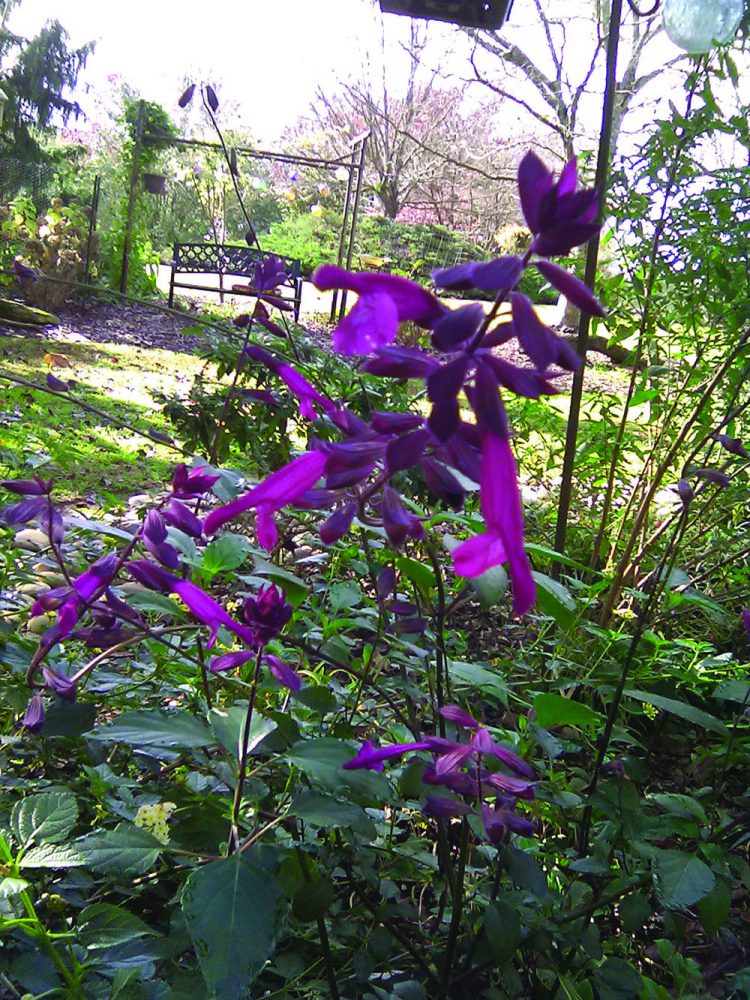Has anyone ever asked you, ‘What’s your favorite flower?” Well, if I could only grow one flowering plant, salvia would certainly be at the top of my list. This wonderfully varied family of plants produces flowers in almost every color of the rainbow…purple, white, red, blue, pink, magenta, and yellow. Salvias, also called sages, are easy to grow, bloom abundantly, and look great in the landscape. They are drought tolerant and have beautiful flowers that attract bees, butterflies, and hummingbirds. Plus, they are deer, bunny, and other garden pest resistant. Who could ask for more?
So, what about salvia? The genus name ¨Salvia¨ comes from the Latin word ¨Salveo¨ meaning to save or heal in reference to the medical properties attributed to some of the plants. This genus has about a 1000 species of soft (herbaceous) and woody plants in the mint family (Lamiaceae) which is often distinguished by their square stems. The red salvia blooms spring through fall and symbolizes ¨forever mine.¨ The blue salvia blooming spring through early summer can be cut back to bloom again in fall and means ¨I think of you.¨ It is often connected to healing… representing wisdom, a long life and good health. It’s common to give this plant to those recovering from an ailment.
Hummingbirds love the nectar of salvias, particularly varieties of red which they can see and bees can´t. Salvia greggii ¨Mirage Cherry Red or Mirage Hot Pink¨ or Salvia microphylla ¨Hot Lips¨ are good choices and bloom spring until freeze. Another red that blooms mid-summer through fall is Salvia elegans ¨Pineapple Sage¨ that stands out in the garden with its chartreuse leaves and red flowers. The ¨Black and Blue Salvia¨ is a hummingbird magnet and one of my favorites with its display of cobalt-blue flower spikes that bloom summer until fall. I particularly like a newer variety of the Black and Blue that has violet-purple flowers that I grow next to the original…it is beautiful. ¨Wendy´s Wish¨ is another favorite of the hummingbirds from the ¨Wish¨ series developed in Australia.
Unfortunately, this is an annual in the Upstate, but the magenta color of the flowers looks wonderful with white and yellow plantings. This plant I purchase every year in a small container because it grows very quickly.
Since it is the middle of November the hummingbirds have since moved on to warmer climates. But all my salvias are quite literally alive with many species of bees including honeybees along with the last of the butterflies…clouded sulphurs, gulf fritillaries, and long-tail skippers. Since the honey bees find salvia nectar so tasty, just be careful when purchasing these plants that they are not contaminated with neonics, a systemic pesticide that distributes a pest-killing nerve poison through the plant’s stems, leaves, flowers, pollen, and nectar. This agricultural pesticide has been implicated in the death of 10 million beehives in the US since 2006.
Salvias are easy to grow and love the heat of the South. They are pretty much drought tolerant once established but occasional watering during long droughts will make them look better. Deadheading is important for continual blooming except for the Mirage series that blooms and blooms and blooms. Salvias need very little fertilizer but appreciate a little dose of Miracle Grow occasionally. Spread a few inches of mulch over roots for the winter…done!
So, I admit, I´m a salvia junkie with at least eleven different species of salvia in my garden. They are easy to grow, add three seasons of color, and attract pollinators. I do believe in the words of a Japanese monk, ¨Ä flower does not think of competing to the flower next to it. It just blooms. ¨ He must have been talking about salvias for just being a salvia is quite enough!■






